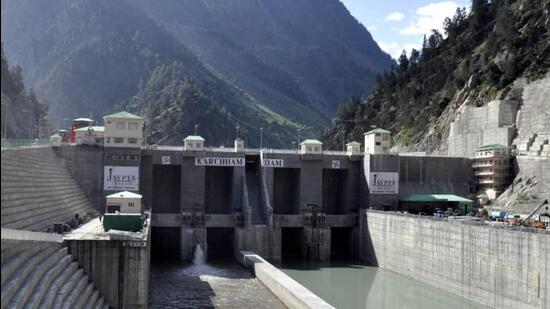Year after monsoon mayhem, Himachal dams yet to install early warning system
The Himachal government claims that it has made most preparations needed to tackle monsoon-triggered disasters
Having taken few lessons from last year’s monsoon mayhem that killed at least 509 in the state last year, the hydel power dams in Himachal are still reluctant to install an early warning system (EWS).

The state government, meanwhile, claims that it has made most preparations needed to tackle monsoon-triggered disasters.
The state government directed the directorate of energy to hold special meetings with Bhakra Beas Management Board (BBMB), Central Water Commission (CWC), and National Dam Safety Authority (NDSA) before the onset of monsoon to address the irregularities in some of the dams during the monsoon season.
The CWC guidelines and section 35 of the Dam Safety Act, 2021, mention the measures taken by dam authorities to reduce the risk in the low-lying areas of the dams. The dams possess large amounts of water and sometimes unexpected release of even a small quantum could catch people unaware and trigger incidents like 24 students drowning in Beas river in 2014.
The safety of the dams is the primary concern of the directorate of energy. Many dams after the government directors installed an early warning system, which includes those managed by the state electricity board, National Thermal Power Corporation, Satluj Jal Vidyut Nigam and Himachal Pradesh Power Corporation Limited.
However, the BBMB management is still reluctant to install an early warning system.
“We have asked all the dams, even the BBMB management dams to install the early warning system, all will have to comply with the state government orders or action will be initiated against them,” said additional chief secretary Onkar Sharma, who is also the Jal Shakti Vibhag additional chief secretary.
“They have sought some time from us. Last year, the monsoon had left a trail of destruction across Himachal, with Mandi being one of the worst-affected regions – where roads were washed away, while houses, bridges and shops,” he added.
Last year, the monsoon had left a trail of destruction across Himachal, with Mandi being one of the worst-affected regions – where roads were washed away, while houses, bridges, shops, and water supply lines were also severely damaged.
Official figures show that 22 people lost their lives in Mandi last year, while nearly 1,000 houses were fully damaged and over 2,000 were partially damaged.
Mandi deputy commissioner Apoorv Devgan said they are in constant communication with BBMB to have an early warning system at Pandoh Dam. “The process is underway and we have been issuing notices to them. However, they have undertaken a few steps including announcement vehicles whenever a large amount of water is discharged. The requirements for the warning system under the Dam Safety Act are under process,” he said.
Further, Devgan said certain other measures have been taken by the district administration to avoid any loss of life and property during the rainy season. “We have recently banned any cutting activity in the district, except in case it is required for any mitigation activity, till August,” he said, adding that the construction of highways is also closely monitored.
The cutting of mountains for any kind of private development and construction activities is completely banned except the disaster mitigation works and reconstruction of affected buildings and roads.
Meanwhile, students in parts of the district are still being taught in temporary accommodations, as hundreds of schools were damaged during last year’s floods. According to the information provided by Education Department officials, around 17 schools were destroyed, and funds for their reconstruction have been received.
Since some of these schools are located in landslide-prone zones, alternate sites are being identified, and FRA clearances for a few schools have been received so far.”
Additionally, around 332 schools were partially damaged in the district. Funds to repair some of these schools have also been received.
Mandi civic body councillors said according to their estimates, there was around a ₹36 crore loss in the Mandi MC area. He said that their demand for this amount from the government is yet to be fulfilled.
Meanwhile, In Kangra, the officials said that they recently held a review meeting and carried out disaster drills. “The work of desilting of Nallahs and other rivulets is also being carried out under MGNREGA,” an official said.
State Disaster Management Authority director DC Rana spoke about the losses from last year, saying, “As many as 1,700 houses were wrecked in the rains. Nearly 210 villages were evacuated due to land subsidence. We engaged various institutions such as to study the landslides and subsidence cases.”
The findings of reports shared with DCs to take remedial actions and prepare mitigation projects. Many proposals under landslide and flood mitigation have been sanctioned and many are in the pipeline
The SDMA, Rana said, has pre-positioned the companies of National Disaster Response Force in Nurpur, Nalagrh, Nagasti in Kinnaur, Kullu and Shimla. “Seeing the vulnerability of Shimla town it’s for the first time that NDRF company is being stationed in Shimla,” he said, adding that mitigation measures is a long-drawn process and time-consuming
A study to analyse the quantum of the damages and relief distributed and sought from the Centre is also underway.
The government now has 180 VSAT sets, while an equal number was present with police. The district administrations have also been asked to stock adequate rations in case tourists are stranded in the state.
“The response was quick last year too even when the magnitude of the disaster had higher intensity,” Rana said, adding that this time the government has alerted the airforce station in Sarwa in advance.






